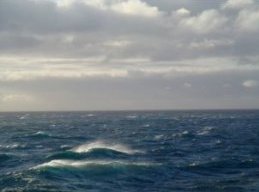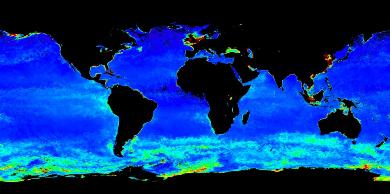Remote sensing reflectance from the southern ocean is higher than most of the world’s oceans (see MODIS image of water leaving radiance at 555 nm averaged over the Boreal Winter below). The bio-optics of the bright Southern Ocean however are complex, leading to both under and overestimations of chlorophyll a and particulate inorganic carbon (PIC) with application of the standard NASA algorithms to SeaWIFS and MODIS imagery. Ultimately the region has been shown to have unique bio-optical relationships. We propose to evaluate two primary hypotheses for the high reflectance:
- 1) Southern Ocean waters contain high levels of backscattering materials such as Particulate Inorganic Carbon (PIC), due in large part to the presence of coccolithophores and coccoliths or
- 2) High reflectance is primarily due to the excessive amounts of bubbles produced by consistently high winds flowing from the west, unimpeded by land masses.
Understanding the magnitude of the spectral reflectance from the Southern Ocean requires a comprehensive assessment of the backscattering properties of the water column with respect to wind-driven processes. We measured both the wind-driven processes (e.g., bubbles and whitecaps) and water-column properties (e.g., calcite, coccolithophores and detached coccoliths, dissolved and particulate organic matter, etc.) during a 35 day cruise in the Atlantic sector of the Southern Ocean in order to evaluate the contribution of each to measured inherent and apparent optical properties. We will work to develop an approach to quantify the contribution of bubbles to water-leaving radiance and to develop a wind-based algorithm to correct for bubbles in the remote sensing reflectance spectrum. Ultimately, this data will be used to refine approaches to remotely estimating phytoplankton chlorophyll and PIC in Southern Ocean waters.
This research is a collaboration with Penny Vlahos, University of Connecticut, William Balch, Bigelow Laboratories, and Mike Twardowski, WET Labs. Project funding comes from NASA Ocean Biology and Biogeochemistry.
 |
 |
 |